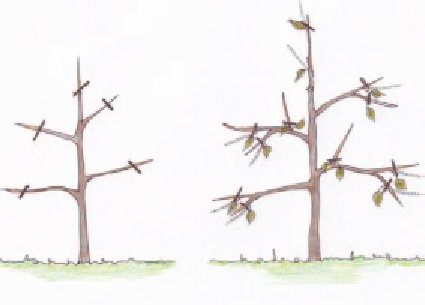Agriculture Reference
In-Depth Information
Figure 5.9
Open vase training.
Figure 5.8
Spindles and pyramids. After initial pruning,
prune new growth in summer to a downward facing bud.
ideal for this method, and planting distances
of 6 to 8 m are needed.
Shorten the side branches by about a third of
their length and trim the the central leader to
1 m to 1.2 m. Prune the summer growth by
about two-thirds to a downward-facing bud.
Pinch out the top of the central leader to a
bud facing the opposite way from where it was
cut the previous winter. Continue to prune
the new growth in summer according to the
type of fruit tree you are growing. When the
central leader has reached the desired height,
cut it back to two buds of the new growth (see
individual entries, pages 143-179, for how to
manage specific fruit trees and long-term
maintenance pruning).
Plant your feathered maiden or whip and
when established prune it back to three
healthy side branches. Shorten the branches
by about two-thirds always pruning to an
outward-facing bud.
FREE-STANDINGTREES
• There are three basic shapes for free-
standing fruit trees
• Pyramid and spindle trees take up the least
space and should be on dwarfing rootstock
• Standard trained trees should not be grown
on windy sites
• Open vase training is excellent for trees
prone to fungal infections, e.g. apricots
• The more horizontal the branches the more
fruitful they are
• Remember that each leaf springs from a
growth point/bud/node that is capable of
originating a shoot/branch
• Don't cut away too much wood in the early
stages of training. The more leaf growth
there is the sooner the plant will establish
Openvase
The open vase shape is the 'traditional' shape
for orchards, producing large trees very open
in the centre with side branches arching
outwards (see Figure 5.10). As a landscape
feature in large grounds, they present the
perfect air of tranquility. Be warned, large
spaces and muscley friends are needed to lug
the ladders required for their maintenance.
Trees grafted onto vigorous rootstocks are





